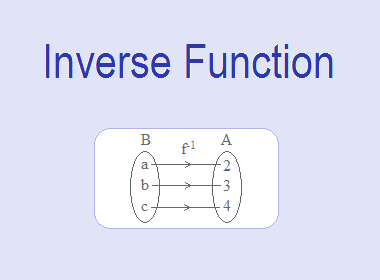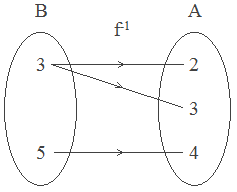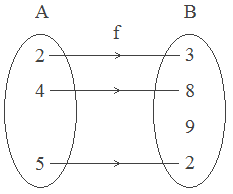
Let A = {2, 3, 4}, B = {a, b, c} and the function f : A → B is
defined by f = {(2, a), (3, b), (4, c)}.

Here,
2 ∈ A, f(2) = a ∈ B
3 ∈ A, f(3) = b ∈ B
4 ∈ A, f(4) = c ∈ B
Also domain of f = {2, 3, 4} and range of f = {a, b, c}.
∴ f is one-to-one onto function.
Now we define a relation g : B → A so that g = {(a, 2), (b, 3),
(c, 4)}.

Here,
a ∈ B, g(a) = 2
b ∈ B, g(b) = 3
c ∈ B, g(c) = 4
So, g is also one-to-one onto function.
********************
10 Math Problems officially announces the release of Quick Math Solver and 10 Math Problems, Apps on Google Play Store for students around the world.
********************
********************
The function g is defined from B to A is said to be the inverse
of f is denoted by f-1. But for every function, there may not exist
its inverse. Let us study the following examples.
1. f = {(2, 3), (3, 3), (4, 5)}.

Here, f is “many to one function.”

Here a relation from B to A is not a function as 3 ∈ B corresponds with more than one element of A. So, f-1
does not exist.
2. f = {(2, 3), (4, 8), (5, 2)}.

Here, f is a one-to-one into function.

Here, a relation from B to A is not a function because 9 ∈ B does not correspond with any element of A. So, f-1 does not exist.
Hence, from the above examples, it is clear that to define an inverse
function f must be a one-to-one onto function.
Definition of Inverse Function:
Let f : A → B be a one-to-one onto function. Then a function
from B to A which associates each element of B with a unique element of A is
called the inverse function of f. The inverse function from B to A is denoted
Worked Out Examples:
Example 1: Let A = {a, b, c} and f : A → A is defined as f = {(a, c), (b, a),
(c, b)}, find f-1.
Solution:
Here,
f = {(a, c), (b, a), (c, b)}
Clearly, the function f is one-to-one onto, hence f-1
exists and
f-1 = {(c, a), (a, b), (b, c)}.
Example 2: Let f : R → R be defined by f(x) = 2x – 3, find the formula that
defines f-1.
Solution:
Here,
f : R → R and x is a variable, f is a one-to-one function, f-1
exists.
y = f(x) = 2x – 3,
To find the inverse function we interchange the role of x and y,
i.e. x = 2y – 3
or, 2y = x + 3
or, y = (x + 3)/2
Hence, inverse function y = f-1(x) = (x + 3)/2



0 comments: